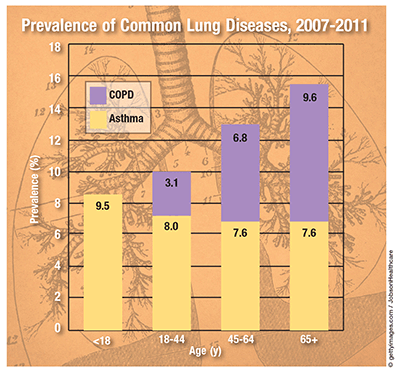US Pharm. 2017;42(7):8.
According to the American Lung Association, more than 35 million Americans have a preventable chronic lung disease. Of all lung diseases in the U.S., asthma is most common (25 million), followed by interstitial lung disease (12 million) and chronic obstructive pulmonary disease (COPD; 11 million). The rate of mortality from obstructive lung disease in women doubled from 1980 to 1994, corresponding to an increase in smoking. Lung disease, the third major cause of death in 2010, includes airway diseases, influenza/pneumonia, interstitial diseases, pulmonary-circulation diseases, and neonatal diseases. Many patients are not compliant with their prescribed medication, and it is estimated that the total cost to the healthcare system is nearly $300 billion annually.

COPD: COPD, which has a prevalence of more than 12 million (possibly 24 million, including undiagnosed cases), is typically irreversible. At least 30 million cases of acute exacerbation of COPD occur annually, at a cost of $28 billion. Infection caused 75% of such cases that were triggered by bacteria, virus, or both virus and bacteria (all, 25%), with an average of three episodes per year. Cigarette smoking was the primary cause in 80% to 90% of all COPD cases. The number of deaths worldwide from COPD is expected to rise from 2.2 million in 1990 to 4.7 million in 2020.
Asthma: Asthma is a disease of reversible airflow obstruction. Acute exacerbation of asthma is slightly more common in males and is more common among people of African and Hispanic origin. Asthma requires less frequent critical care or hospitalization compared with COPD. Current inhaled treatments can offer a 20% reduction in exacerbations, whereas biological therapies offer a reduction in exacerbations of up to 60%.
Cost: The CDC projects that COPD treatment costs could rise from $59.3 billion in 2010 to $90.6 billion by 2020. Excluding costs for COPD-related injuries, the cost was $32.1 billion in 2010 and is projected to be $49.0 billion by 2020. In 2010, Medicare, Medicaid, and private insurance paid 51%, 25%, and 18%, respectively, of these costs. If all patients were fully compliant with their prescribed medication for COPD, exacerbations could be reduced by 25% to 30% annually, at a savings of $4 billion per year. The cost of successfully helping all noncompliant COPD patients adhere to their prescribed treatment is an estimated $3 billion. The overall annual cost of asthma treatment is $18 billion, with an average of $3,000 to $7,000 as out-of-pocket expenses that vary according to the severity of the condition. The cost of successfully helping all noncompliant asthma patients adhere to the prescribed treatment is estimated at $8 billion.
To comment on this article, contact rdavidson@uspharmacist.com.






